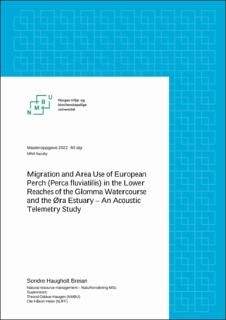| dc.contributor.advisor | Heier, Ole Håkon | |
| dc.contributor.advisor | Haugen, Thrond Oddvar | |
| dc.contributor.author | Breian, Sondre Haugholt | |
| dc.coverage.spatial | Norway | en_US |
| dc.date.accessioned | 2022-09-05T12:27:05Z | |
| dc.date.available | 2022-09-05T12:27:05Z | |
| dc.date.issued | 2022 | |
| dc.identifier.uri | https://hdl.handle.net/11250/3015806 | |
| dc.description.abstract | The amount of research done on migration patterns for European perch (Perca fluviatilis) between fresh and brackish water is limited, and it is uncertain how these populations of perch utilize the different habitats throughout the year and the timing of migration and what are the drivers behind these. This study aims at enlightening some of these enigmatic patterns and mechanisms by monitoring the migration and habitat use of individual perch in the Visterflo- Glomma-Øra system in southeastern Norway.
Acoustic telemetry was conducted for tracking 25 individuals of perch using tags equipped with depth sensors. All individuals were captured using rod-and-line during the summer/early autumn at two different locations: Øra and Visterflo, considered the two main gathering areas for perch in summertime (Øra) and autumn (Visterflo). A total of 30 acoustic receivers were placed throughout the study area, covering both freshwater and brackish-water habitats. These passive receivers logged signals throughout the June-November 2021 study period.
The telemetry data revealed tremendous inter-individual variation in habitat- and depth utilization between individuals throughout the study. 12 of the 14 perch tagged at Øra returned to Visterflo in the autumn while two disappeared from the dataset. Statistical modeling showed that day-to-day variations in water discharge and -temperatures were the main factors triggering return migration from Øra to Visterflo. All tagged perch in Visterflo during June, chose to stay in Visterflo the entire summer.
No perch smaller than 20 cm were caught or observed at the Øra station, and the perch that chose to migrate had faster growth and better condition. This can indicate that the perch has to reach a certain size before migrating to brackish water areas to feed and grow during the summer months. It is still uncertain what makes the perch choose to migrate between Visterflo and Øra. This population is probably genetically predisposed to this migration pattern, but this must be investigated further in comparison to other populations in the same watercourse. | en_US |
| dc.description.abstract | Mengden forskning som finnes på migrasjonsmønstre for europeisk abbor som benytter ferskvann og brakkvann er begrenset. Det er høyst usikkert hvordan disse populasjonene utnytter de ulike habitatene gjennom året, samt når de velger å migrere mellom disse. Denne studien hadde som mål å få klarhet i noen av hemmelighetene til denne unike og høyt verdsatte abborbestanden i Norge for å forstå atferds- og vekstmønsteret bedre. | en_US |
| dc.language.iso | eng | en_US |
| dc.publisher | Norwegian University of Life Sciences, Ås | en_US |
| dc.rights | Attribution-NonCommercial-NoDerivatives 4.0 Internasjonal | * |
| dc.rights.uri | http://creativecommons.org/licenses/by-nc-nd/4.0/deed.no | * |
| dc.subject | Glomma | en_US |
| dc.subject | Øra | en_US |
| dc.subject | Visterflo | en_US |
| dc.subject | Abbor | en_US |
| dc.subject | Ferskvannsfisk | en_US |
| dc.title | Migration and area use of European perch (Perca fluviatilis) in the lower reaches of the Glomma watercourse and the Øra estuary : an acoustic telemetry study | en_US |
| dc.type | Master thesis | en_US |
| dc.subject.nsi | VDP::Matematikk og Naturvitenskap: 400::Zoologiske og botaniske fag: 480 | en_US |
| dc.description.localcode | M-NF | en_US |

